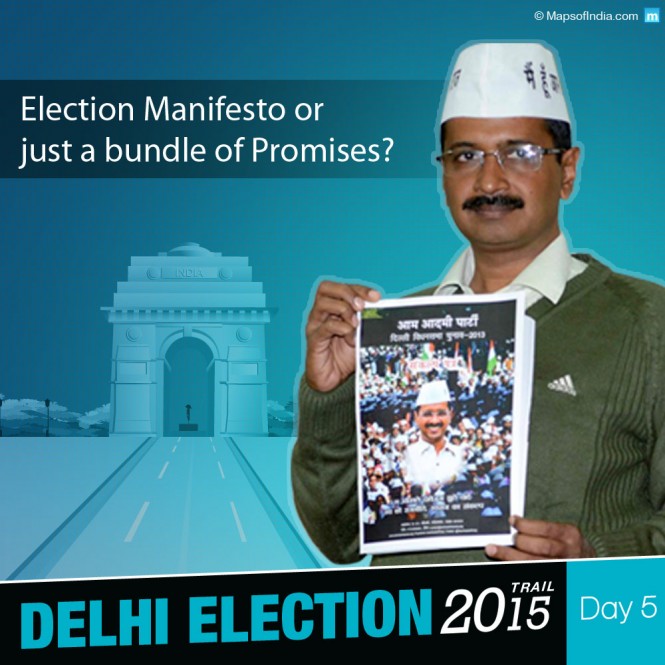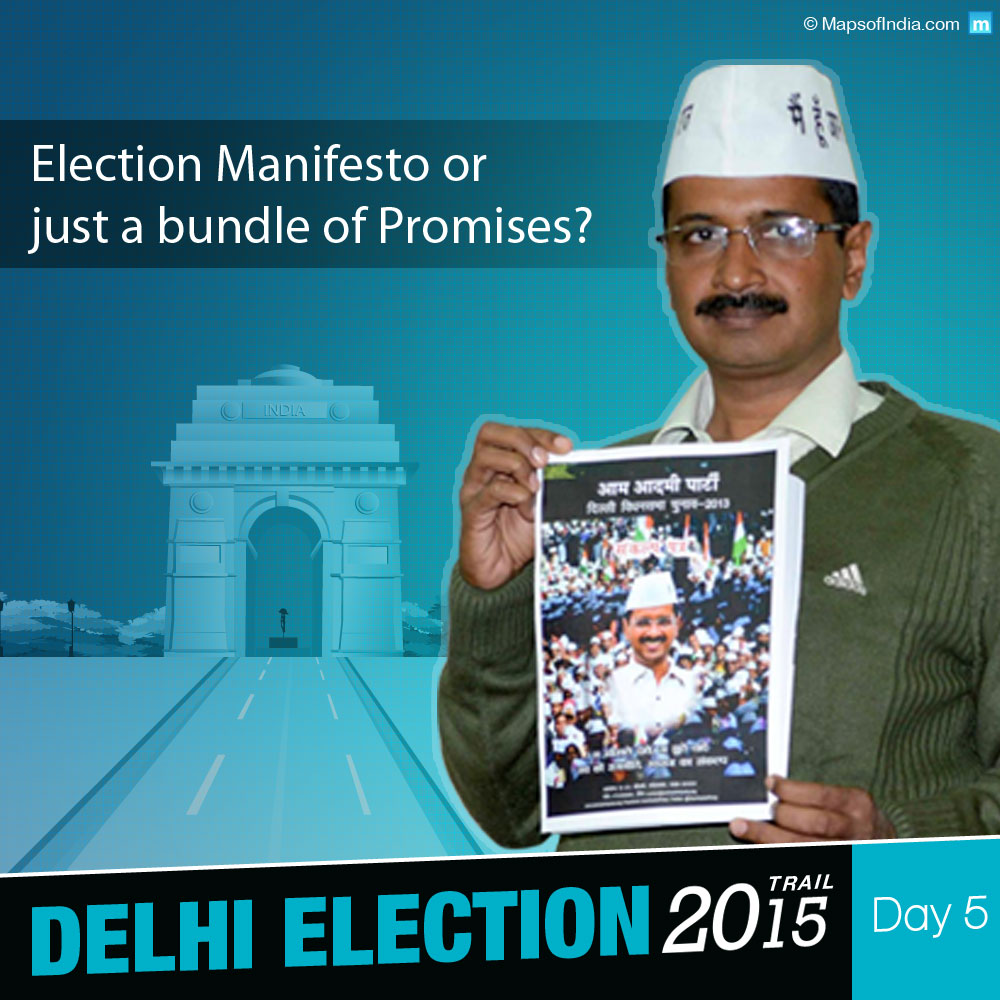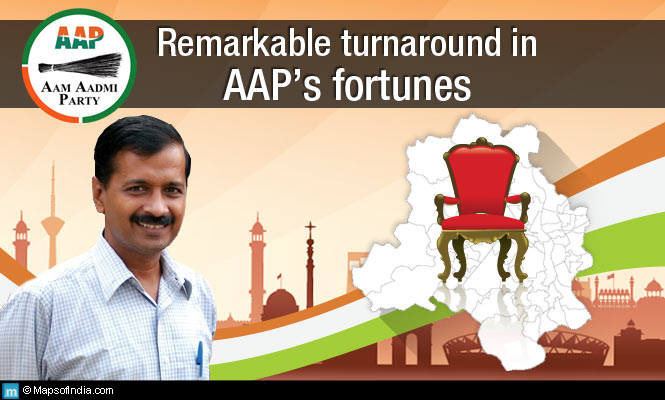 Is AAP’s 70-point election manifesto an actionable plan or a bundle of promises?
Is AAP’s 70-point election manifesto an actionable plan or a bundle of promises?
Remember the BJP’s repeated yet unfulfilled promises of abrogating Article 370, introducing Uniform Civil Code and constructing Ram Temple in Ayodhya in its successive poll manifestos? Similarly, what about the Congress’ promises of alleviating poverty, curbing violence against women and so on, in its poll manifestos?
With elections, comes a flurry of promises – to curb inflation, fast track development, provide pucca houses to slum dwellers, reduce the power and water tariff, take steps for women’s safety and offer better provisions for education.
Yet, they remain unrealised. Therefore, there is little surprise that such promises are overlapping in all manifestos even now.
With every political party harping on the same unfulfilled promises, poll manifestos are losing their relevance and elections are turning into personality clashes. That is probably why the BJP even dropped the idea of releasing its poll manifesto for 2015 Delhi assembly elections, and instead released the ‘Vision Document 2050’ of Prime Minister Narendra Modi for the national capital.
Don’t you think that the 270-point agenda in the BJP’s Vision document, 42-page AAP manifesto, and two volumes of the Congress manifesto mean that the political parties are promising the moon to the people of Delhi?
Just consider that the BJP manifesto does not provide any specification on reduction of VAT or reduction of power tariff and free water! It is in this backdrop that the poll promises of the three main political parties need to be evaluated.
Full Statehood for Delhi – A Myth
To begin with, just consider the AAP’s promise to get full statehood for Delhi in its poll manifesto. The demand for full statehood has been there for quite some time but it never fructified. Reported differences within BJP over the contentious issue of according full statehood to Delhi is one reason why the party junked the idea of releasing poll manifesto. The reason was understandable – the Congress had conspicuously failed to achieve full statehood for Delhi even when its government was ruling the Centre for a decade as well as the national capital for 15 years. What is bizarre is that the Congress still mentioned full statehood as a poll promise in its 2015 manifesto. So, doesn’t such a promise by both Congress and AAP indicate a lip service? Also consider that this time neither AAP nor Congress has its government in Centre, which is ruled by the BJP, which again stands divided over this issue.
A reason cited by the AAP for full statehood is to bring the police under the state government. This demand has been raised time and again but the Centre has refused to budge given the status of Delhi as the national capital. Only Parliament can bring the Delhi police under the state government and with just four members of parliament, how can the AAP fulfill its promise is anyone’s guess. While the Congress, too, promises the same, it may be mentioned that the longest serving Chief Minister Sheila Dikshit, who ruled Delhi for 15 long years, failed to get the police under her control despite regularly pitching for it, and in spite of the fact that in the last 10 years of her rule, the Congress was at the helm of power. Remember, that even the AAP leader Arvind Kejriwal created history by becoming the first chief minister to sit on a dharna in January 2014 to press for his demand of bringing Delhi police under his jurisdiction,.
Assuming that the AAP succeeds in achieving its promise, the question thereafter will arise over the cost of maintaining such a force. Will his government resort to taxing the citizens to bear the additional annual cost of over Rs 5,000 crore required to run the police force, when Delhi’s overall budget is just Rs 36,700 crore? It is therefore imperative to look at the BJP’s Vision Document. Instead of promising to bring the police under Delhi government, it promises special measures to improve their work condition and training to enhance their capabilities.
Swaraj – Is it achievable?
The AAP promises to operationalise the idea of Swaraj through the constitution of Mohalla Sabhas. By Swaraj, the party means self-governance by
a)attaining full statehood and
b) making communities the primary locus of decision making.
The Mohalla Sabhas are envisioned as empowered bodies of all the adults in a locality or colony that complements the state government, which will largely be concerned with macro-level decisions. This sounds good on papers. But how will the AAP keep the rogue elements away from these Sabhas? Moreover, is it possible to constitute them without consulting the city’s three municipal corporations, all of which are under the BJP’s control? While a significant part of the Mohalla Sabhas will come under their jurisdiction, the AAP cannot keep these corporations out of the decision-making process. So would not the Mohalla Sabha-Municipal Corporation clash seem imminent? It may be mentioned that these corporations were elected in 2012 and have an elected life till 2017.
New Power Plant – Can they get environmental clearance?
Yet another poll promise in the AAP manifesto that seems hard to fulfill is the promise to set up a new power plant in Delhi. It requires environmental clearance and questions are already being raised on whether Delhi can house such a power plant without risking its environment. Consider that the Congress manifesto restricts itself to inducting more power distribution companies to provide better services to the citizens. The BJP’s Vision document sound more achievable as it envisages “generous government funding” for setting up large solar power panels on top of public buildings and roofs of residential buildings to meet the power demand. It promises to make Delhi the ‘Solar Energy Capital’.
Corruption – Can it be curbed?
The issue of Corruption, though it figures in all manifestos, does not occupy the same prime space that it had occupied in 2013. The term “corruption” has been replaced by “Swaraj” in the AAP’s manifesto and it is under this section that the party promises a Delhi Jan Lokpal Bill to check corruption at high places. The BJP promises to make the Lokayukta “more effective and powerful” and also promises to set up an “Accountability Commission” to ensure proper and efficient use of public funds.
The Congress promises in its manifesto a “full proof system to weed out corruption…” Yet, it has not spelt out the details of such a system.
Women’s Safety – Still a far cry
Women’s security has been one of the most sensitive issues in recent times, especially after a spurt in rape cases in Delhi. Unable to curb it when in power, the Congress now promises more recruitment in the civil defence forces including women; special training of the police force along with increasing the number of women in the police;CCTV cameras on all public transport; security gates and CCTV cameras in colonies from MLA funds, as well as gender training for the entire government workforce and auto rickshaw drivers as well to ensure the safety and security of women.
The AAP goes a step further and promises “adequate street lighting” and CCTV cameras even in the FIR registration rooms “to monitor whether the police are registering all FIRs. Besides, the party manifesto also promises setting up of a special “Women’s Security Force”. But won’t this new force further burden the state exchequer? The BJP, too, promises a ‘Women Security Force’ under the CM’s office. It also promises dedicated police station for women in every district. Yet, what is significant is that the BJP’s Vision Document has no specific mention of the party’s CM aspirant Kiran Bedi’s pet six ‘Ps’ that she had outlined to ensure holistic security of women – People (parents, principals), Politicians, Police, Prosecution, Prisons and Press with government as the hub. How can the party ensure women’s safety when Delhi Police still reports to the Union Home Ministry and the party is cryptically silent on full statehood for Delhi, that alone would ensure police coming under the state government’s wings?
Unauthorised Colonies – Quintessential vote banks
Yet another contentious issue that holds the key to the fate of political parties in elections is the issue of unauthorised colonies in Delhi. There is a broad consensus on legalising these colonies among all political parties because over 70 lakh people live in the 1642 unauthorised colonies in the city. After all, their votes influence elections in no uncertain way. Yet, the issue of regularisation of these colonies figures in every manifesto during elections. This time again, they figure in the agenda of all political parties. Consider them:
The Congress manifesto takes credit for the in-situ construction of flats to rehabilitate those living in the Jhuggi Jhopri clusters. It lauds its “commendable” work of constructing roads, laying of water, power and sewer lines in the Lal Dora areas (Urban Villages) and the villages falling in the capital’s territory. It hits out at the AAP and the BJP, for “stalling” these works in the last one year.
In turn, the AAP in its manifesto accuses the Congress of “deceiving” the residents of these unauthorised colonies before each election. It points out that on 24 March, 2008 Delhi’s Congress government had issued a notification for regularisation of unauthorised colonies but after winning the elections, ”the Congress forgot the promise”. The AAP now promises to regularise these colonies “within one year” of coming to power! The BJP too promises to regularise all illegal colonies that came up before 2014.
Development – The new buzzword
‘Development’ is the latest buzzword in Delhi assembly elections following BJP’s unprecedented win on such a plank in 2014 General Elections and the subsequent assembly elections in four states. Hence, political parties are now chanting the development mantra in Delhi, accusing each other in the process for the lack of development in national capital in recent times. Taking credit for the city’s all-round development during its 15-year rule, the Congress in its manifesto claims that development works were stalled for the last one year. The AAP, on its part, promises granting of special status and funds to rural areas of Delhi. The BJP’s development agenda for Delhi comprises 6 ‘S’ – “Saaksher (literate), Swachh (clean), Swasth (healthy), Sakshum (capable), Surakshit (secure) and Sanskari (ethical) Dilli. It promises to make Delhi a “world class city”.
Job Creation and Skill Development – Wooing Delhi’s youths
With over 3.5 lakh voters in the last elections, youths are the new vote banks to be wooed by political parties. The AAP promises emphasis on creating jobs. It promises to fulfill 55,000 “immediate” vacancies in the government. To lure the youth, it further promises to provide free Wi-Fi, enhancing sporting facilities, promoting higher education and ensuring a “drug free” Delhi. Both the AAP as well as the Congress promise 20 new colleges in the city state. The Congress also promises 150 new schools and subsidised higher education for targeted low-income group. Not to be left behind, the AAP promises 500 new school and hospitals to generate employment besides setting up vocational training institutes to empower 17 lakh people in the next five years. The BJP, too, promises new educational institutes and is offering somewhat similar sops to the youth.
With so many promises in manifestos, can Delhi now hope to raise its status as a truly world class city? Keep the fingers crossed.
Related Information:





